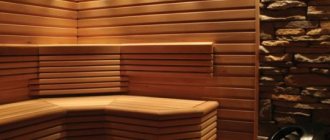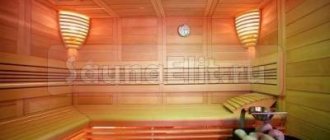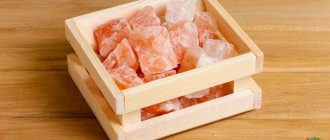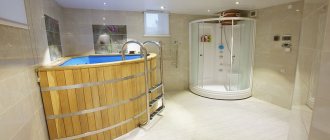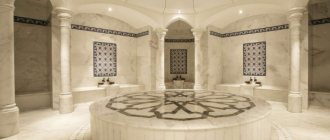Increasingly, Himalayan salt is used in modern baths, which provides a powerful healing effect on the human body.
Salt has a natural crystalline base consisting of 85 useful microelements.
Himalayan bath salt is used to treat diseases of the respiratory system, cardiovascular and central nervous systems, and to prevent colds.
In the baths, equipped with various salt elements, the air is purified and ionized.
Use Cases
It is most convenient to use salt in the bath in the form of briquettes or pebbles. They are not destroyed by temperatures. When heated, negatively charged ions are released from them, which disinfect the air in the bathhouse and create a microclimate in it close to the sea.
Kinds
Salt is the cheapest means for bathing procedures. Several types of salts can be used in a steam bath:
Stone
The usual rock table salt, which is used by every housewife for cooking. Its peculiarity lies in its fine grinding and possible mineral additives. It is necessary to monitor the composition of the substance: it should not contain fragrances or harmful chemical additives.
Marine
It is large, enriched with elements characteristic of sea water, which means it is very close to the composition of blood and therefore the use of sea salt is very useful. Effective for treating skin diseases, removes toxins, heals wounds, stimulates sweat production.
Himalayan
You can buy it in a specialized store for baths or saunas, in hardware or perfume departments of household stores. It enriches the body with barium and sodium, the properties increase many times when heated.
Important! There are contraindications for use: renal failure, cancer, glaucoma, tuberculosis, blood diseases. It is a valuable mineral formed during centuries of volcanic activity and mined in the Himalayan mountains of the Punjab province of Pakistan. Salt, which contains more than 90 useful chemical elements, is extracted manually, so it is recognized as one of the most environmentally friendly substances used in everyday life.
Salt, which contains more than 90 useful chemical elements, is extracted manually, so it is recognized as one of the most environmentally friendly substances used in everyday life.
It is a valuable mineral formed during centuries of volcanic activity and mined in the Himalayan mountains of the Punjab province of Pakistan. Salt, which contains more than 90 useful chemical elements, is extracted manually, so it is recognized as one of the most environmentally friendly substances used in everyday life.
Depending on the inclusion of iron oxide in the substance, salt is classified into 3 types: pink, red and black. Pink and red are especially popular.
In a Russian steam room or sauna, Himalayan salt can be used in the form of:
- bricks - they are used to lay out small walls in the steam room;
- tiles - cover the walls;
- pebbles (from a pea to a walnut in size) - placed on the stove and sprinkled with water to release steam;
- sand from medium and coarse salt - used to scrub the body or prepare a solution for wiping.
Properties
When used correctly in a bath, Himalayan (pink) salt begins to behave in a special way: the higher the temperature, the brighter its healing and preventive properties are revealed, but the higher the humidity, the faster the salt breaks down and melts quickly (the permissible humidity for it is only 50% ). Therefore, the bathhouse must have good ventilation.
Since the basis of Himalayan salt is sodium chloride (like table salt), its medicinal, cosmetic and preventive properties are the same as sea salt and regular table salt.
But the following features of this substance deserve special attention:
- salt is a humidity stabilizer in the bath - it immediately begins to absorb excess water and replenish the deficiency;
- has a strong antiseptic property - laid out on the floor will not only exfoliate the feet, but will also disinfect the surface;
- is capable of dry ionization of the room - for this it is placed in small wicker containers in the corners of the steam room;
Types of bath salts, benefits and harms
The most popular and expensive type of salt from which bath stones are made is Himalayan. It is mined in the Himalayas, which have a reputation for being an ecologically clean place. Salt is mined there in the form of lumps, which are subsequently given different shapes. They are black or pink in color. Slabs or blocks made from mineral are used in finishing. They are used to create salt rooms.
Real Himalayan salt is expensive. On sale you can come across a fake of it, which does not have the properties of a natural material.
Since ancient times, Himalayan salt has been used in alternative medicine to treat various diseases. With its help, Eastern healers struggled with various problems of the skin, respiratory organs, dysfunction of the heart muscle, nervous disorders, joint diseases and even allergies.
It is believed that Himalayan salt vapors can cope with metabolic disorders. Blocks and slabs made from it in baths are used to line walls, ceilings and floors. Special adhesives are used to attach them. You can walk on salt floors without slippers. They have antiseptic properties.
This type of finishing material has a unique pattern and textured surface. Decorating rooms from it is an expensive pleasure. Rooms lined with Himalayan salt slabs should not have an air humidity of more than 55%. Excess moisture destroys their structure.
To obtain a healing effect, you can be content with little. For example, cover only the heater with salt slabs or throw Himalayan salt pebbles onto the heater grate. A good healing effect can be achieved by hanging a small amount of minerals in a decorative bowl in the bathhouse. In addition to its beneficial properties, Himalayan salt also has its contraindications.
People who have:
- malignant tumors;
- tuberculosis;
- acute stages of blood diseases and glaucoma;
- mineral intolerance.
In addition to Himalayan salt, stones made from other types of minerals are used in the baths. These include salt:
- stone;
- marine;
- Altai
Stone
Bath stones made from this type of minerals can be ordered from specialized online stores or made independently from ordinary table salt. To do this, place it in a canvas bag, moisten it well and hang it in the sun to dry.
The stones obtained in this way are placed on the stove grate. The vapors they emit soften the air in the bathhouse.
It is useful for them to breathe when:
- sore throat;
- bronchitis;
- sinusitis;
- otitis;
- conjunctivitis, etc.
Moist salty air rejuvenates the skin, calms the nervous system and promotes sleep. In such a bath, all wounds and pustular skin lesions are disinfected.
Expert opinion
Levin Dmitry Konstantinovich
Since ancient times, rock salt has been used for massage. Despite all its beneficial properties, ordinary rock salt has the least healing effect.
Marine
The composition of this type of mineral contains significantly more useful substances than rock salt. It contains: iodine, magnesium, bromine and calcium. They increase skin elasticity, strengthen hair and nails. For baths, sea salt is produced in the form of briquettes. Their composition can be additionally enriched with various ether compounds.
It is convenient to place briquettes on the stove grate. The vapors they emit when heated are useful to inhale to prevent respiratory diseases and improve immunity. They cleanse the body of toxins and have a general strengthening effect.
Altai
Minerals are mined in lakes of the Altai region. They are considered one of the most useful natural materials on the planet. Altai salt contains bacteria and microorganisms. It is used to treat psoriasis and eczema and has hypoallergenic properties. Using Altai salt stones in a bath helps improve the appearance of the skin. Salt vapors balance the nervous system and solve the problem of insomnia.
What bath salt do you use?
HimalayanOther species
Various herbs are often added to the composition of Altai salt bath stones. When they are heated on the grill of the heater, the process of salt releasing negatively charged ions starts. They have an antiseptic effect on the human body, normalize blood circulation and cleanse the respiratory organs. In the trade you can buy Altai bath salt in the form of briquettes.
What is Himalayan salt
Himalayan salt is also suitable for cooking dishes, making them more piquant and delicious.
This is rock salt that is mined in Pakistan from the Khewra salt mine. It is located just 300 km from the Himalayan mountain range, which is why the mineral bears this name. According to the latest research, this salt was formed during the Jurassic period during volcanic processes between India and Eurasia. It appeared simultaneously with the Himalayas, after which it began to slowly settle down and accumulate - this is how the deposits that are now developed by people were formed.
Features of Himalayan salt are as follows:
- salty-sweet taste, unlike ordinary table salt;
- soft pleasant aroma;
- pink-orange color due to impurities of iron and other minerals;
- about 90 different microelements in the composition;
- 100% digestibility by the body;
- the lowest content of sodium chloride among all types of salt (for example, table salt consists of 98% of it, which is why it is harmful in large quantities);
- manual mining without the use of machines or explosives;
- no refining;
There are other deposits in different countries, but all of them are one way or another close to the Himalayas
Most often, the mineral has a pink or reddish color, but a black tint is also observed. This unusual color scheme makes the Khewra mine a popular tourist attraction. Among all the salt mines, including the extraction of ordinary table salt, Khewra ranks second in terms of production volumes, and third in terms of mineral reserves.
Black Himalayan salt is very similar to pink salt in structure and nature. It is distinguished by a pungent odor of hydrogen sulfide, but when heated it completely disappears. Black salt is also suitable for consumption. Hindus add it to traditional spices and to the national dish raita.
How to use it correctly
The easiest way to use salt stones in a sauna is to place them on a heater. For these purposes, it is better to use small stones such as pebbles. It has a size of 2-3 cm and can withstand temperatures up to 550 degrees. The special bath product has a number of significant differences from table salt.
The most common bath salt stones are halite. They are made from Himalayan salt. Their main component is sodium chloride.
In total, halites contain more than 80 components. When exposed to high temperatures, salt rocks begin to release mineral compounds into the atmosphere, which enter the human body during respiration. Some of the mineral compounds settle on the skin and penetrate through the pores, which expand under the influence of heated air.
The composition of the air in the steam room, equipped with salt stones, is identical to that of the sea and ocean.
Steam room air saturated with microelements has a positive effect on the human body:
- relaxes and relieves nervous tension;
- heals small wounds and cracks on the skin, restoring its structure;
- enriches the body's cells with oxygen and stimulates blood circulation processes;
- relieves joint pain;
- removes toxins and waste from the body with sweat;
- kills fungal microorganisms;
- eliminates foci of inflammation in the respiratory system.
An additional healing effect can be achieved by combining salt stones with herbal infusions in a bath.
The duration of inhalation of salt stone vapors to obtain the maximum therapeutic effect should be at least 25 minutes.
Regular visits to such a bath can help solve many skin problems, as well as chronic diseases of the respiratory system. Baths with salt stones should be well ventilated. High air humidity should not be allowed in them.
Useful properties of the mineral
Himalayan salt is a complex healing mineral. It is recommended not only by practitioners of alternative medicine, but also by doctors with good education and extensive experience. Salt has the following beneficial properties:
- supplies the body with important microelements (for example, iron, the lack of which is felt by many city residents);
- Helps cleanse the body and remove toxins;
- accelerates the restoration of damaged cells;
- calms the nerves;
- tones all the muscles of the body;
- kills harmful bacteria;
- externally rejuvenates the body;
- increases blood flow to the extremities (useful for people whose hands and feet are always cold).
Medical recommendations for the use of salt from the Himalayas boil down to the enormous benefits of its evaporation. The mineral evaporates when heated - both during cooking and during bath procedures. Salt vapors can treat a number of diseases:
- diseases of the digestive system;
- ailments of the genitourinary system;
- asthma;
- problems with the musculoskeletal system;
- vascular and heart diseases;
- hypertension;
- psoriasis, dermatitis and other skin problems;
- allergic reactions;
- irritation and inflammation of the gums;
- chronic fatigue.
You can also rinse your mouth with a salt solution to achieve fresh breath. And compresses or baths with saline solution relieve swelling on the legs and remove blue bags under the eyes.
Production technology
Natural mineral deposits contain undesirable components. They are removed during the production of bath stones using special cleaning technologies. Crystal clear salt mass is formed into pieces or monolithic materials under high pressure.
Only Himalayan salt is not purified. The value of this mineral is due to the high content of iron in its composition. Altai and sea salt are removed from excess moisture by evaporation.
Advantages and disadvantages
When the air in the sauna is heated with the required amount of moisture, the salt begins to evaporate and replenish the body with the most important microelements. Thanks to it, the nervous system calms down, toxins are eliminated - the body is completely cleansed. All muscles of the body become toned, blood flow to the extremities improves. In addition to all this, harmful bacteria are destroyed, since salt has an antiseptic effect, and damaged cells are quickly restored.
It has diuretic effects on the body: appetite increases, metabolism improves, and if a hangover is present, its symptoms decrease. Salt vapors have a laxative effect on the intestines and relieve joint pain. Doctors do not doubt its healing properties, so they safely prescribe bath procedures with it.
Indications for this include diseases of the digestive and genitourinary, respiratory and cardiovascular systems, skin rashes from psoriasis, and allergic reactions. Rinsing the mouth with a salt solution relieves irritation and inflammation of the gums. Using compresses eliminates blue bags under the eyes and improves complexion. In addition, salt with a fine structure can be rubbed on a body already heated in a steam room. It is necessary to rub it into the skin with massage movements - not only will a scrubbing effect occur, but also the opening of the pores to replenish the lack of microelements.
Bathing procedures with salt will in no way harm the body, even with frequent use. But to use it for food, there are some restrictions and contraindications that must be adhered to. Salt can have a negative effect on the body of people who have malignant tumors and blood diseases. The use of salt is strictly contraindicated for pregnant women, especially in the last stages, and for people who have renal failure, tuberculosis and varicose veins.
How to decorate a bathhouse with it
It is best to use Himalayan salt blocks for these purposes. The mineral is enriched in magma. The finishing material is obtained from it using special technology. It has a high degree of strength and can withstand significant loads.
To reduce the cost of decorating a bathhouse with Himalayan salt slabs, you can limit yourself to fragmentary wall decoration. It is best to use this material in finishing dressing rooms, not steam rooms. It is much easier to maintain the humidity necessary to maintain the integrity of the material.
The plates are attached to the surfaces with a special two-component glue, which is made on the basis of magnesite. It is mixed with magnesium chloride in a ratio of 3:5. First, magnesium chloride is dissolved in warm water, and then magnesite is added to it. The average consumption of such glue is 1 kg per 1 sq. m.
Laying slabs on such adhesive must be done extremely carefully, because the texture of the fastening material has an unattractive appearance. You can replace this glue with liquid glass. Its binder composition is less durable, but will serve for some time. You can also find special glue for Himalayan salt on sale. Its composition is non-toxic.
Expert opinion
Levin Dmitry Konstantinovich
You can attach salt tiles to a wooden surface only after treating it with coarse sandpaper.
Glass surfaces are pre-degreased and treated with fine-grained sandpaper. The adhesive layer during finishing must be at least 1 cm. It must dry without drafts.
Salty greetings from the Himalayas
In order to effectively saturate the air in the steam room with the healing components of a natural mineral, it is recommended to prepare a solution of salt in water and splash it on the heater. To do this, add 1-1.5 g of crystals to 1 liter of water, use the liquid after the solid particles have completely dissolved.
It is noteworthy that it is difficult to overdo it with introducing salt into the body using the above methods, but there is a therapeutic and health effect. However, it would be advisable to consult a doctor to eliminate the risk of unforeseen situations.
Himalayan bath salt is one of the latest fashion trends in modern bath culture. And this fashion trend is based on several factors:
- In the concept of the average person, the Himalayas are a kind of sacred place where truth is born.
- A very eco-friendly place, not polluted by the costs of civilization, by the way, one of the few on the planet.
- The mountain range is home to many religious and philosophical movements, as well as non-traditional types of healing. The concept of Tibetan medicine has been known to our people since the early days of dear Leonid Ilyich.
- Himalayan salt in a bath is a mineral that is balanced in composition and has excellent organoleptic properties. Naturally, if it is a natural product and not its imitation.
- Both black and pink Himalayan salt for sauna have now become more accessible both in terms of price and availability on the market.
After purchasing this miracle drug, the question naturally arises - Himalayan bath salt, how to use it with maximum benefit and impact. The recommendations are simple and clear:
- Himalayan salt in a steam room, as the basis of a salt wall, is an extremely expensive pleasure. Examine the samples carefully for their identity. The probability of getting a fake at a considerable price is very high;
- If the heater in the steam room is of a closed type and open at the top, you can use salt pebbles for salt ionization of the air. Pebbles are crystals of natural salt that range in size from a pea to a walnut. They are laid out on hot stones and periodically sprinkled with clean water. Let’s be honest, in this mode the pebbles melt literally before our eyes, however, they were not purchased as bath decor;
- Local placement of wicker baskets with pieces of salt in the corners of the steam room. In this option, dry ionization occurs, the saturation of the steam room atmosphere is carried out more softly and delicately, in lower concentrations. And the salt consumption is not the same as in the previous version;
- Oral and external use of low concentration saline solutions. Use this method after prior consultation with your doctor. Internal intake of salt can disrupt the water-salt balance of the body, and various wraps, rubbing, and scrubbing can cause irritation of the skin. Naturally, salt for such use must be of guaranteed quality and from a trusted supplier.
We suggest you familiarize yourself with How to heat concrete correctly: warm it up at home
Question answer
How long does 1 salt briquette last?
One salt briquette weighing 750 g is designed for 4 baths.
Are there any benefits to lamps made from Himalayan salt and can they be installed in bathhouses?
Lamps made from Himalayan salt can be installed both in the steam room and in the dressing room. They have the same healing effect as bath stones. The best place to install them is in the corners of rooms.
Where is the best place in the bathhouse to hang a bowl of salt stones?
Bowls with salt stones should be hung from the ceiling or on the wall as close to the heat source as possible.
What's the best way to use salt bricks?
Salt bricks can be used to line a heater or install a floor. This material consists of 100% Himalayan salt and has unique antiseptic properties.
Is it possible to spray water on salt rocks?
Water is sprinkled onto the salt stones after they have warmed up well. Short-term exposure to moisture does not destroy their structure.
Salt stones have healing properties. They are heat resistant and have high strength. Stones have their contraindications. You can use them in a bath after consulting a doctor.
Features of a trip to a salt bath
It has always been believed that a salt sauna is designed for high temperatures (about 70 degrees) and low indoor humidity (30%). It is by following these parameters that you can achieve maximum results. In addition, the use of Himalayan salt is even more effective for healing the body. But due to the high temperature, you can stay in such a sauna for no more than 15 minutes.
However, recently it has been found that even at an air temperature in a steam room of 50 degrees, the healing properties of salt are preserved. In addition, in this case the load on the body is significantly reduced, which allows you to stay in the steam room longer.
As the salt heats up, the microparticles begin to ionize, thereby saturating the air with ions. Himalayan salt at this time perfectly cleanses the lungs, thereby providing some drainage to the bronchi, which improves the patency of the respiratory system. In addition, breathing salt vapor is very useful in preventing colds.
If you have a need or want to always be healthy and avoid epidemics of colds, you should visit salt baths regularly. Himalayan salt has a healing effect on both the skin and the heart and even normalizes blood pressure
The most important thing is to correctly put stress on the body and introduce such procedures into your life gradually, starting with low temperatures and a small amount of time, gradually increasing
Good to know: How to go to the bathhouse correctly.
Methods of using salt in a bath
One of the simplest options for using salt in a bath is to soak the salt in warm water and rub it with massage movements. The main thing is not to forget to steam your body well before taking such procedures. To do this, you need to go into the sauna and stay there for at least minutes. Afterwards, you can start applying salt to your body, but you don’t need to do this on your face and neck; you need to sit in this position for about 5 minutes. If you want to use another broom, you need to wait until the salt has completely dissolved. You need to remember that no one can massage you better than a broom to get rid of cellulite. Salt is the best scrub made from natural ingredients.
You can prepare a solution from salt that can be used to wipe the entire skin. To prepare the solution, you need to dissolve a glass of salt in a glass of water.
As an option, you can visit baths, in which instead of stones there are salt crystals, filling the air with essential elements and minerals, which have a beneficial effect on the skin, the respiratory system and the entire body.
What does salt go with in a bath?
A smear of honey and salt. To make it, you need to melt honey with salt, using two parts of salt for one part of honey. The mixture is applied to the steamed body, after which you can lie down for 15-20 minutes.
Bath salt scrub. To make it, just mix salt and honey together until you get a thick foam, which is applied to the body using the principle of massage movements. After application, you need to wait 30 minutes and then rinse everything off. After this procedure, the skin feels light and airy.
A popular mixture is butter and salt or cream and salt. The proteins contained in milk have a positive effect on the skin. Alternatively, you can use vegetable oil with salt. You just need to know which oil is right for you. The most commonly used is olive oil.
Harm and contraindications
When carrying out salt procedures in a sauna, you need to know the contraindications, otherwise you can cause harm to your health. Please note that honey is a very allergenic product. Therefore, the use of salt and honey by people with allergies is prohibited.
You should avoid using a salt bath in cases of skin damage or skin diseases.
A salt sauna is useful not only for people suffering from any diseases, but also for absolutely healthy people. Visiting such a sauna, you will be surprised how smooth and silky your skin will be after the procedure.
The benefits and harms of such a bath are closely interconnected; the most important thing is to know what you should not do during such procedures
The following rules should be followed:
- salt saunas should not be visited at high body temperatures, or during exacerbation of diseases;
- observe the time spent in the steam room, it should not exceed 30 minutes;
- You should not eat heavy food before your visit.
Prepared by PersonSport.ru
The influence of baths and saunas on women
Bath for colds
Salt cave effect in your own steam room
There are several options for integrating a natural mineral into the arrangement of a bath complex. In the steam room, the walls and floor are made of monolithic salt blocks. Under the influence of a humid environment and high temperature conditions, a microclimate with a high content of sodium and chlorine ions is formed in the internal space. As a result, a sufficient concentration of active substances is created, which causes the effect of the notorious salt cave.
Installation of mineral blocks is carried out using special compounds. During construction work, silicate glue - liquid glass - or a two-component compound can be used. The wall can be erected on suspensions using a supporting frame made of lumber. When arranging a structure, spotlights are often introduced in the form of built-in LED devices. The result is an impressive composition with a mesmerizing sparkle of crystals.
Principles of creation and nuances of operation of a steam room with the effect of a salt cave:
- Using monolithic mineral blocks, one or more walls are laid out. It is worth considering that the durability of the structure depends on the intensity of bath procedures;
- the floor, made of salt blocks, is actively subject to destruction. The walls, if you do not overdo it with steam, will last quite a long time;
- It is enough to decorate one wall with monolithic blocks to provide the effect of a salt cave on a limited budget.
The good thing about this method is that the walls and floors made of salt monoliths work on their own: active compounds are released, the air in the steam room is saturated with chlorine and sodium ions, creating a favorable microclimate with a healing effect.
Beneficial properties and healing effects of Himalayan salt
Whatever the quality, Himalayan salt is used, due to its environmental purity and the content of a complex of minerals, it has a healing effect and relieves diseases:
- genitourinary system;
- mouth, throat;
- heart, blood vessels;
- oncological;
- joints;
- skin;
- hypertension;
- bronchi and lungs;
- organs of the digestive tract.
Additionally, Himalayan salt:
- speeds up metabolism;
- performs a cleansing function, removes decay products;
- strengthens the immune system;
- relaxes the muscle frame;
- relieves nervous tension, eliminates the effects of stress;
- has a beneficial effect on the structure and relief of the skin;
- maintains water-salt balance;
- copes with insomnia;
- eliminates chronic fatigue syndrome;
- heals wounds, cleanses the dermis of acne;
- stimulates brain activity.
The healing properties of salt are revealed under the influence of high temperatures. Negative ions are released into the air, destroying pathogens.
Entering the blood through the respiratory tract, microparticles of minerals have a healing effect.
The benefits of pink salt when used in baths and saunas are as follows:
- Salt helps get rid of chronic rhinitis, reduce inflammation in the bronchi, and cleanse the lungs of stagnant mucus. Clean, disinfected air is beneficial for asthma patients. With regular visits to baths and saunas using Himalayan salt, the frequency of attacks decreases and the severity of allergic reactions decreases.
- The blood is enriched with oxygen, which is necessary for the normal functioning of internal organs.
Hot water with Himalayan salt has properties similar to water from natural hot springs.
- In a bathhouse or sauna, under the influence of hot steam, blood circulation accelerates, pores open on the skin, and ions of trace elements penetrate the dermis faster. The body is detoxified.
- Steam with particles of Himalayan salt inhibits the development of colds in the initial stages and is a prevention of infectious diseases.
- Replenishment of missing minerals - potassium, calcium, fluorine, iodine, copper, iron - normalizes hematopoiesis, brain activity, and stabilizes blood pressure. The condition of hair, nails, and skin improves.
- Salt triggers metabolic processes that eliminate digestive disorders. Sclerotic plaques and salt deposits in the joints and spine are destroyed.
Water charged with negative ions affects the psycho-emotional state and improves mood.
By strengthening the immune defense, bath procedures have a restorative, healing, and rejuvenating effect on the body.
Should I give up salt?
Giving up salt is one of the first stages of losing weight and switching to a healthy lifestyle. The harm of normalized salt intake is the most useless and inveterate myth of nutritionology.
Potassium is the main ion of cells, sodium is the main ion of blood. These elements are responsible for salt balance and enter the human body only with certain foods.
If the concentration of sodium and potassium is in harmony, then:
- the liquid is evenly distributed throughout the body;
- transport functions are improved;
- nervous activity is harmonized;
- the muscular corset and skeletal system are supported.
Microelements are needed by the body in certain quantities. The sodium to potassium ratio should be between 1:2 and 1:4. What is the rationale for this particular balance? In prehistoric times, our ancestors served as hunters and gatherers of plant foods. Sodium appeared extremely rarely in the diet of people of that time, so the body learned to synthesize it on its own. Potassium, on the contrary, was fully supplied with food, so there was no need to preserve it. The diet and pace of human life have changed significantly. We have unlimited access to food, and any discrepancy between micro- and macronutrients can be balanced with the help of medications.
A healthy adult needs 1 teaspoon of salt per day. With excessive physical exertion or serious fluid loss, the dosage is increased to 2-3 teaspoons.
Do not forget that salt comes into the body from vegetables, fish, meat, and not just from a teaspoon, which you divide into several meals. Excess sodium leads to edema and kidney and heart diseases.
To counteract the effects of sodium, a high concentration of potassium must be present in the diet. List of neutralizing products:
- filtered water (1 liter/1 gram sodium);
- dried apricots, raisins;
- bran;
- seeds;
- potato;
- cashews, almonds, peanuts, pine nuts, hazelnuts;
- prunes;
- beans, buckwheat;
- parsley, Brussels sprouts, porcini mushrooms.
Contraindications
The benefits and harms of Himalayan salt are incommensurable, but nevertheless there are contraindications for use. The list of conditions and diseases for which visits to salt baths and saunas are not indicated includes:
- viral and bacterial infections accompanied by fever;
- exacerbation of chronic diseases;
- liver and kidney pathologies;
- diabetes;
- decreased blood clotting;
- neoplasms of any etiology;
- epilepsy;
- tuberculosis.
Women are advised to refrain from procedures during menstruation.
How to glue salt tiles or bricks
If you have chosen the adhesive method of installing salt walls made of tiles or bricks, remember: it must be done only with special glue. It allows the structure to be firmly fixed to bases made of wood, brick, concrete and other materials, and, importantly, contains substances that prevent the formation of mold and mildew. In this case, it is necessary to mix the glue strictly according to the instructions: only then will it be resistant to changes in temperature and humidity for many years. It must be applied to clean, dry surfaces using a comb spatula.
Benefits of using salt bricks
Until relatively recently, salt brick was actively used to decorate walls in residential premises and special lamps, which made it possible to improve the microclimate in rooms.
Salt brick is an environmentally friendly material.
Such bricks have a unique natural composition. They consist of 60% sodium chloride, 35% potassium, and about 15% are other complex elements that have a pronounced antibacterial effect. Such additions to the interior can significantly improve the condition of people suffering from frequent respiratory infections, as well as respiratory diseases of an infectious and allergic nature.
Recently, bricks and slabs have begun to be used in the construction of baths and saunas. There are certain subtleties in this matter, because the salt that is used for their production quickly begins to interact with water. Therefore, the relative humidity in the bath should not exceed 53%. At the same time, short-term exceedings of these limits will not have a particular negative impact on this material. In order to get the maximum benefit from using this material, masonry must be done in close proximity to heat sources. The most important advantages of salt bricks include:
- pronounced disinfecting effect;
- improving skin metabolism;
- absolute environmental friendliness;
- ability to withstand high temperatures;
- complete sterility;
- ability to ionize air.
At the same time, it must be taken into account that baths that use salt bricks or slabs require frequent ventilation to create an optimal microclimate, since high humidity has a very negative effect on the condition of such slabs, and a coating that looks very much like frost may begin to form on them. In some cases, to prevent brick destruction, it is advisable to install a ventilation system that allows you to quickly eliminate high levels of humidity.
Application of salt blocks
The mineral is used in the sauna as blocks, bricks or slabs. The difference between these forms is their thickness:
- the salt block has a thickness of 100 mm;
- salt brick for a bath is 50 mm thick;
- The thickness of the salt slab is 25 mm.
Brick or salt tiles for a bath allow you to make a decorative panel. The materials are glued together using a special glue, which can be bought in a special store. It is mixed with water in the proportion specified in the instructions. The product is applied directly to the brick or tile in a thin layer.
The floor in the steam room is made of salt bricks or blocks. This flooring has antiseptic properties, so you can walk on it with bare feet.
In order for bath salt to be used as efficiently as possible, it is important to create favorable conditions, the description of which is given below.
To maximize the effect of salt, the humidity in the steam room should not exceed 50%
- Indoor humidity should not exceed 50 percent.
- The steam room must be regularly ventilated, or a high-quality ventilation system must be installed in it so that the salt finish lasts a long time.
- To connect salt materials to each other, it is recommended to use a mixture of magnesium chloride and magnesite in a ratio of 5:3 or special glue.
When installing salt blocks in a sauna, the adhesive must be applied carefully. After four hours, the adhesive mass will reliably hold all the materials together.

